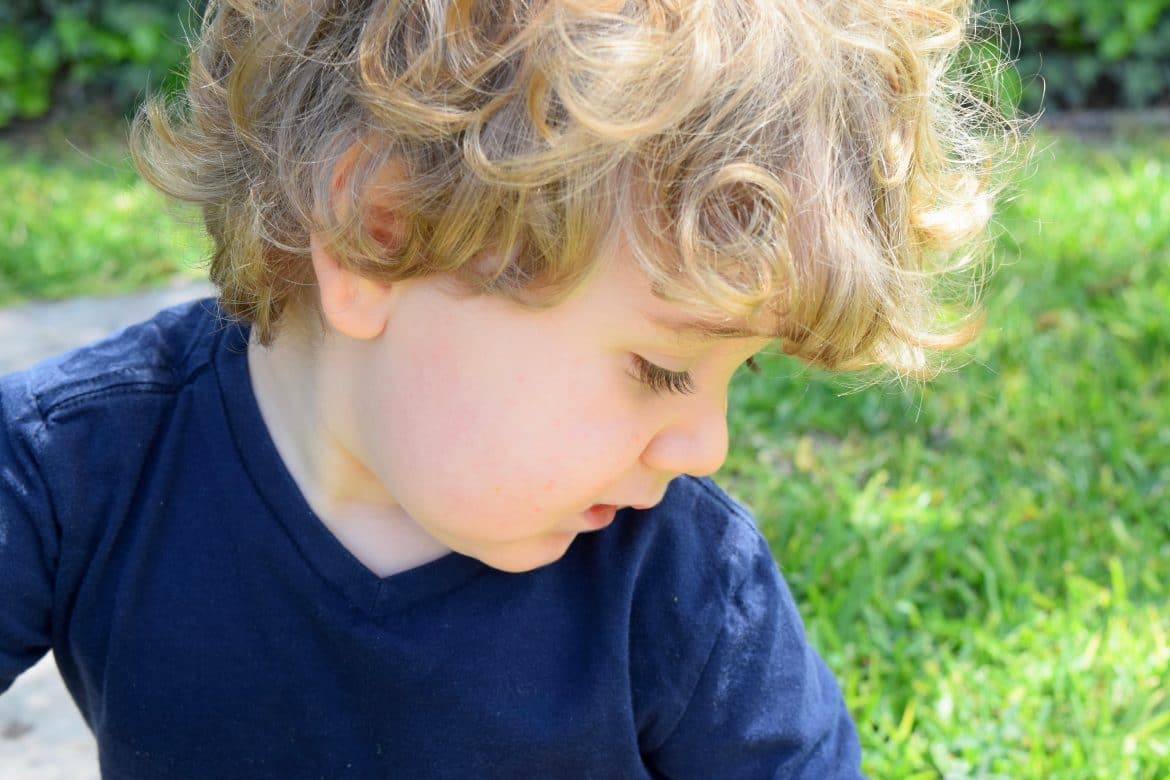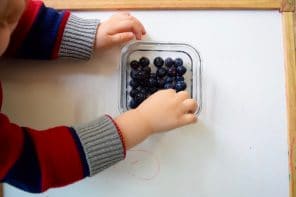Sometimes I feel like there’s a pressure to do more with my three year old son. As parents, we all hear about the importance of sitting down to play with our children, giving them our undivided attention, and using opportune moments to teach things like language. Especially when he was an infant and young toddler, I felt like I had to constantly be talking to him and stimulating him with toys and images and facts and attention. To be perfectly honest, it was exhausting. I’m a quiet, introverted person, so this was often just too much for me. And for my son? It was actually too much for him too.
All of that stuff is indeed important. Kids need attention, love and for us to occasionally sit down and do something with them. But being constantly in their faces or making sure they are always entertained is not doing them any good. Children need to play by themselves.
The realization that my son needed to play independently struck me hard this year as I noticed that he wouldn’t just sit down to play. Unless I sat down with him and his toys, he would follow me around creating chaos. I was burnt out and he was loosing the opportunity to be fully engaged in play.
Aside from the sanity it saves us parents, why is independent play so important? Independent play is when children, particularly small children, learn. Sure, we can sit and show them how to write or read or do math, but the majority of their development occurs during play. Playtime is when they figure out the important things, like how to socialize, what it feels like to be in different roles, and what roles they want to be in. They use playtime to work through difficult ideas and situations like conflict, death, change, embarrassment, empathy, sadness, anger, etc. When they are given the space to play and work through what they see in a big and scary world, they are calmer and happier. And if you’re worried about scholastics, fear not because independent play serves as the foundation of higher and more complex knowledge. Independent play gives them the opportunity to start teaching themselves about gravity and balance, patterns and geometry, story structure, sequence, solving problems,
With just a few changes and simple steps, I’ve been able to totally transform the way my son plays.
- Provide open ended toys. The first and biggest step towards independent play is giving them toys that will facilitate that. Toys that only work one way or that are nothing but flashing lights and noisy buttons serve no benefit to children or their play. They direct the child on how to play rather than the child leading. Toys that are simple, non-electronic, and that can be used in multiple ways are ideal. This includes toys like blocks, dolls, simple vehicles, play silks, sticks, pinecones, rocks, leaves, and play animals. I also recommend avoiding characters from movies and television because they already have a story and a personality, rather than the child coming up with it themselves.
- Make sure that toys are accessible, age appropriate, and few. If you need to be getting toys out for them, this can be a distraction as well as a subtle way of shifting control back to you. We want children to feel in control of their play so that they continue to direct it. Also make sure that toys are age appropriate. Toys that are too difficult for them to manipulate will only lead to frustration, another play distraction. And lastly, don’t provide too many toys at once. Having stacks of toys to choose from is overwhelming and can cause too many distractions and decisions for a small kid.
- Make the time for play. Our schedules can be so busy that there often isn’t much time for kids to be fully engrossed in play. Providing a free hour here and there for them to just be kids and retreat to their imaginations does wonders for their development and the quality of their play.
- Turn off electronics. Television and tablets are the ultimate killer of independent play. They are passive entertainment that feed ideas to the child and keep them occupied. I’ll be totally honest and clear, I’m not saying never plop your child down in front of a screen. They can be lifesavers for busy parents and in small doses, is really fine. But relying on screens instead of play is detrimental to their ability to play independently and takes time away from when they could be playing.
- Give enough attention. Outside of playtime, make sure that your child is getting enough undivided attention. When kids feel secure and like they have received the attention that they need, they are more likely to shift their focus back onto something else. Attention and love are real needs for children, so making sure those needs are met first ensures that they will be better able to focus on a different need, like play. Involve them in your day by giving them small tasks. Or let them help with chores like folding laundry or sweeping. Or more importantly, sit with them and just keep your focus totally on the child. Let them talk and ask questions. Offer snuggles and kisses and affection. You will both feel more fulfilled, calmer, and ready to tackle the next thing.
- Provide a few gentle prompts. Especially at first, kids don’t always know how to start playing on their own. They may see a mountain of toys and things to manipulate, but not know where to begin or often how to use the toys at all. With time, they will come up with their own ideas, but giving them a few jumping off points is incredibly helpful for both of you. Try setting out an invitation to play with their toys. For example, arrange the blocks and some toy animals like a forest. Don’t say anything or even tell them what it is, just leave it as an open invitation with no pressure.
- Stay nearby. Children like to feel secure that you are close enough to provide help and attention should they need it. So at first, choose a simple and non-distracting activity for yourself, like knitting or reading. This is so the child sees that you are still close, but that you are focused on something else. I feel
- Let them figure it out. When they are young, it can be so tempting to jump in so that they do things “right”. Whether it be fixing a block structure so it’s more stable or correcting the use of a toy, all involvement like this is both distracting and discouraging to children. They will figure it out themselves, which is a large purpose of independent play. We want their play to be hands on learning and exploration. Plus, if we constantly intervene, they will rely on you to guide their play. It’s magical to watch children come up with stories and worlds that are as unique as they are detailed and interesting.
- Let them be. The biggest challenge for me was to stay silent and let my child be during play. I was so used to saying things like, “look at you build that tower” or “the cars are going so fast” or anything that acknowledged that I was watching him play. But all of these little interjections were distractions and each time I did it, I was pulling him back out from his focus. Staying focused and involved in their play is what independent play is all about and when they are free and able to get lost in their imaginations.
- Shift control back to them. When a child comes up to you and asks for you to do something for him, such as building their tower or playing a part in their play, keep shifting the control back to them. We can help them with things that are truly difficult for them (like taking apart those tiny legos) but if they can do it, they should do it. Say things like, “Sure, I’ll help, but I’d like you to try again first” or providing verbal instructions help to keep them in the leadership role. And if they want you to participate, be as passive as possible. For example, say they want you to be the giraffe in their small world animal play, ask things like “What is the giraffe doing?”, “Is the giraffe happy about that?”, “Oh my, tell me more about what happened”, and “Oh wow, and then what happens?” There’s no reason why we can be kind to our kids and be there when they request it, but keep them in charge.
Keep your expectations realistic. The smaller the child, the smaller their attention span. Most kids won’t play for hours on end as their attention will wax and wane naturally. But independent play is possible and your sanity is salvageable. Just give it time and you will soon see your child flourish as they explore the wonders of independent play.






